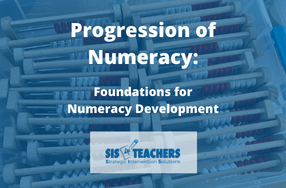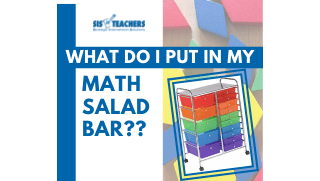When you think of “curriculum,” what comes to mind? For most of us, our first thought is of that book that we use to teach that particular subject.
 When a school district requests math training, the first question I always ask is What is your district’s curricular framework? Responses vary, but usually they’ll respond with the name of their district-purchased book – Math Expressions, Everyday Math, Eureka Math (the list goes on!). However, as we’ve talked about before, the book isn’t the curriculum, it’s a resource to support the true curriculum, which is the standards. So, what I really want to know when I’m asking about curriculum is how they design and structure their standards in that district. Sometimes, we find out that there isn’t anything in place, that the textbook is handed to teachers as if it is the curriculum that they are to present to students.
When a school district requests math training, the first question I always ask is What is your district’s curricular framework? Responses vary, but usually they’ll respond with the name of their district-purchased book – Math Expressions, Everyday Math, Eureka Math (the list goes on!). However, as we’ve talked about before, the book isn’t the curriculum, it’s a resource to support the true curriculum, which is the standards. So, what I really want to know when I’m asking about curriculum is how they design and structure their standards in that district. Sometimes, we find out that there isn’t anything in place, that the textbook is handed to teachers as if it is the curriculum that they are to present to students.
Think of it from this perspective: You are a first grade teacher that is now teaching fifth grade. You were just handed the math book and told, “Here you go, have fun!” How do you feel?? We know that the math books aren’t written for all students, but are geared more towards those students in the middle, so how do you know what to teach? Maybe you’re a new teacher that just hired on – whether you just graduated from college or are a seasoned teacher that has moved from another state that has a different set of standards. You get the book and are expected to dive right in.
While textbooks might be a wealth of information and resources, they can also be a source of stress and pressure for many teachers. They get a lovely pacing guide that, when followed exactly, which ensures that the textbook and student workbooks are used from cover to cover and that informs us when our students, regardless of prior knowledge or foundational skill level, should have mastered a new skill (even though the pacing guide can often be misinterpreted!). If only it were that easy!
Instruction by Design, Not Textbook
As we know, it’s never that easy. There are many important components to consider as we look at different ways to implement curriculum design in schools. There are many curricular frameworks, like Backwards Design, Integrated Course Design, 5Es, Universal Design for Learning, etc. This summer, we worked with eleven elementary schools in two different districts to purposefully design their curriculum using the instruction by design framework. We call it “instruction by design,” but I think of it backwards; for the first time in my career, I’ve been able to examine instruction and actually design it for the students I’m working with. The very same lesson can be taught in two completely different ways depending on the students’ number sense and numeracy. Kids understand things differently based on where they are academically, or even the demographics of the school (affluent or at-risk),
So, instruction by design lets you take the gloves off, peel back the layers and really take a look at the standards. It lets you dive deep into the standards, see where students are falling, and then, after some reflection, map the standards out in a way where we identify power standards, supporting standards and light touch standards.
When you’re initially starting the work of instruction by design, all the standards seem really important. We know students are going to be tested on these standards so we have to figure out how to organize them. While we wish there was an already-prepared set of power standards you could pick up and start teaching, this process has to be completed with knowledge of your current group of students in mind. And even if you find power standards, they might not be the first thing you start with! So how do you do this?
Beginning the Process

Instruction by design organizes standards into units of study. With two of our districts this summer, the program we worked with was Eureka Math, which uses modules. Most curricular design frameworks have 8-9 units that don’t necessarily follow the modules from their district-purchased book/program. For our project, we still used a lot of the research-based pieces from Eureka Math, but we designed the curriculum for implementation based on what we knew about the students in these two districts we were working with, pulling from various modules to complete our units. We mapped out our unit topics based on the standards that we were looking at and how we wanted to proceed.
As we began to fill in the units, we felt that the best way to find power standards was to go through the data, but then we realized that the data we had collected was a bit skewed. This led to the conclusion that the power standards we thought were important weren’t actually the standards that were important. This was partially due to the assessment framework in the district that is more generalized. We saw general areas of weakness reflected in the data, such as number sense or geometry, but we weren’t able to drill down enough to show us exactly what standards were causing problems.
This focus document (see right), similar to a chart from the Common Core Mathematics Companion, came in particularly handy as a reference for our design process. I love it because it’s simple and color coded. A green box indicates a power standard. A blue square indicates supporting standards and a yellow circle represents your light touch standards. Overall, it shows you the standards that might be tested in that grade level or that represent the most important things. This coherence map from Achieve the Core is another tool we used that could be really helpful as you lay out all the standards (read the whole blog post here!)
In third grade, the teachers and I began examining the document with a clean slate of expectations as far as what their power standards might be. Usually, in 3rd grade, we think that kids need to learn place value and addition and subtraction, but the document showed that multiplication and division actually make up a great deal of our year. We also found that the only number sense standards with place value, addition and subtraction were marked with yellow circles, telling us that they were supposed to be light touch standards.
However, knowing the scores and past academic levels of our students, we felt like these number sense standards were actually really important, even though they were indicated to be light touch standards. As a result, we decided those standards would be a large priority for us in 3rd grade. Many of the books and math resources start the 3rd grade year with multiplication and division instead of place value and addition and subtraction. Where you start your 3rd grade year should depend on your students, not the table of contents.
We proceeded to map out which standards to teach when within each grade level, and this process can definitely get messy. So we borrowed a more structured approach from another county in Michigan that uses quarterly promises (If your school uses trimesters, you could create trimester promises instead). Each quarter is about 10 weeks long, but how many of those days do we actually have for instruction? We excluded PD days, the first and last weeks of school (let’s be honest – how much instruction do we get to in those days??), testing days, field trip days, and really drill down how many days of math instruction you actually have. With that number in mind, we had a better idea of what we were working with as we mapped out our standards and when to teach them. Once we had our quarterly promises identified, we had a road map for diving into the other portions of instruction by design.
Here’s an example of quarterly promises for 3rd grade in one of our districts:

Click here to view the template in Google Docs. To create your own, editable, copy, of the template, click the Use Template button in the top right.
 For third grade, we wanted to use some of those light touch standards that we identified we came up with for unit one. We designed it around place value, addition and subtraction and then we went into multiplication and division. The nice part about these units is that you’re designing them by the standards. Yes, you may use your math resource (district-purchased book/program) and say that these certain lessons, modules or chapters might fit into those standards, but you’re not really “going through the book.” Instead, you are simply looking at how the standards would map out and how they might cluster together.
For third grade, we wanted to use some of those light touch standards that we identified we came up with for unit one. We designed it around place value, addition and subtraction and then we went into multiplication and division. The nice part about these units is that you’re designing them by the standards. Yes, you may use your math resource (district-purchased book/program) and say that these certain lessons, modules or chapters might fit into those standards, but you’re not really “going through the book.” Instead, you are simply looking at how the standards would map out and how they might cluster together.
With instruction by design, you have the freedom to teach addition and subtraction within measurement and you might combine those topics because your students do well that way. However, you might also decide not to combine those things because your students can’t do all those things at once and so you can work on addition and subtraction, then bring in the measurement later on.
What We Learned
The whole process was really freeing. As we mapped and prioritized the standards, as we started looking at them more carefully, talking with colleagues, and learning more about the standards themselves, we found that the map changed. We referenced the Common Core Mathematics Companion to make sure we were really understanding the standards and we used tons of post-it notes around the room so we could easily switch things up as we began to think differently.
There are lots of books that have been written for Understanding by Design that you can read if you want to know more about the research behind the framework, but we wanted to show you what it was like to go through the process of designing instruction from my perspective and from the teachers’ perspectives as we implemented something that was really sound.

While we’ve spent the summer working on creating a curricular framework for two of our districts, I feel quite strongly that one size does NOT fit all when it comes to curriculum. I couldn’t take what we’ve spent the past four or five months working on and go into another school district that has different socio-economics than the school district it was designed for and say, “this will work for you!” As much as we wish there was a magic button that would create a ready-to-use framework for us, it doesn’t work like that.
Curriculum is never completed, and instruction by design requires revisions. I once had a curriculum director say to me that their curriculum was done! But it is never done! A curriculum is a living thing that is always examined and changes to meet the needs of a changing student body. We must take time to look at whether or not the work that we did worked the way we wanted it to. We must ask ourselves reflective questions: Do the assessments directly tie to the priority standards that we have laid out in our quarterly promises? How did we perform on our summative and interim assessments and our performance tasks and our student reflections to make sure that what we’re doing is implemented properly?
This whole design process has opened my eyes on a whole new level. For most of my consulting career, I’ve been focused on teaching and implementing instructional strategies, whether they are interventions or not. However, if the curricular framework we’re working with isn’t suitable for the students we’re working with, we can keep implementing instructional strategies all day, we can go through the textbook page by page and cover every single lesson, but it doesn’t mean that the child will have the growth that we’re looking for, it doesn’t mean that we’ve raised student achievement, it doesn’t mean that the child is getting any better at what they’re doing.
What’s Next?
Step one in this process developing our curricular framework is really understanding instruction by design. Understanding it will be presented in units, that you map out the standards that correlate with the units, you design instruction for the students you are working with.
Next week, we’ll talk about where we go from here. Where do you go after you lay out your quarterly promises? What is the next step? We’ll talk about some of the bumps in the road that we encountered and some of the stressors we faced as we started to enter into this process.







